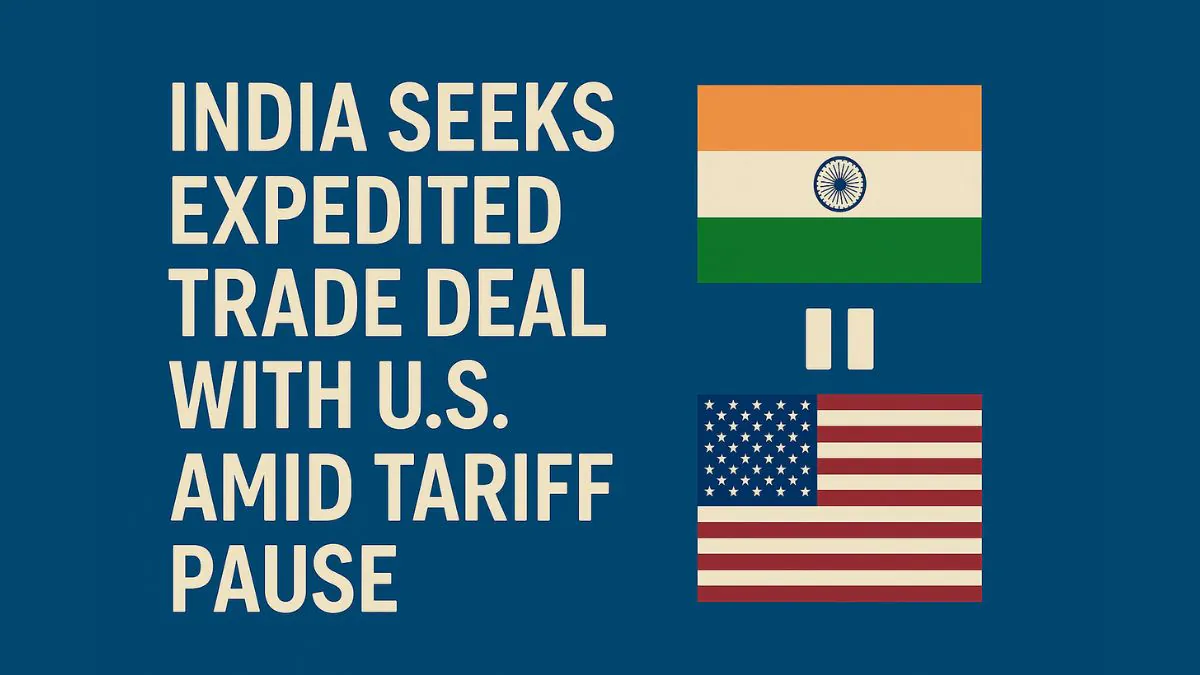90-Day Tariff Pause: India Races to Finalize Trade Deal with U.S.

Table of Contents
ToggleShare this article ↷
On April 9, 2025, the U.S. announced a 90-day tariff pause on reciprocal tariffs for many countries, including India. This move has given Indian exporters a golden chance to breathe easy and push for a solid trade deal with the U.S.
But what does this mean for us desi folks? Let’s break it down in simple terms, with a bit of masti and some serious gyaan!
Read also: Govt Plans Export Support Measures – Key Sectors to Gain
What’s the 90-Day Tariff Pause All About?
The U.S. had planned hefty tariffs-basically extra taxes-on goods coming from India and other countries. But after some market jitters and talks with over 75 nations, they hit the pause button for 90 days.
During this time, India’s goods will face only a 10% baseline tariff instead of higher rates. China, though, wasn’t so lucky-it’s now dealing with a massive 125% tariff. For India, this 90-day tariff pause is like a Diwali bonus, especially for exporters of shrimp, textiles, and electronics.
This breather is a big deal because it gives India time to finalize a trade agreement with the U.S. The goal? Boost two-way trade to $500 billion by 2030, as agreed in February 2025. Indian officials are racing against the clock to lock in this deal before the pause ends.
How Does This Affect Your Personal Finance?
You might be wondering, “Bhai, how does this affect my wallet?” Well, here’s the connection to personal finance. When exporters like our shrimp-do well, they earn more dollars. This can strengthen the rupee, meaning imported stuff (think phones or petrol) might not burn a bigger hole in your pocket. Plus, more trade could mean more jobs in India, giving your family or friends better income options. It’s all connected, yaar!
India’s Game Plan: Fast-Track the Deal
Indian exporters are calling this pause a “balle-balle moment.” Shrimp exporters are thrilled since the U.S. is a huge market for them. The government is now in top gear, working on a partial trade deal that covers key products.
According to the Ministry of Commerce and Industry, India’s pushing hard to make this happen within 90 days. The plan includes lowering duties on some U.S. imports too, so both sides win.
Experts from the Federation of Indian Export Organisations say this is a “make-or-break” window. If India nails this deal, it could dodge future tariffs and boost exports even more. That’s good news for our economy-and your personal finance in the long run.
Key Takeaways
The 90-day tariff pause is India’s chance to shine. It’s a relief for exporters, a boost for jobs, and a possible win for your budget. So, keep an eye on this trade drama-it’s not just about big businesses; it’s about our daily paisa too!
Got thoughts? Drop a comment below or share this with your dost log. Let’s chat about how India can make the most of this!
Disclaimer
Well Returns is not a financial adviser. The content provided here is for informational purposes only and is intended to offer a brief overview and general knowledge. It is not a substitute for professional financial advice. Please consult a qualified financial adviser before making any financial decisions or investments.
Related FAQs
The 90-day tariff pause is a temporary halt on higher taxes (tariffs) on goods from India and other countries, starting April 9, 2025. It keeps tariffs at 10% for now, giving India time to finalize a trade deal with the U.S.
This pause reduces export costs, making Indian goods like shrimp and textiles cheaper in the U.S. It helps exporters earn more and compete better, especially against countries like China facing higher tariffs.
India wants to secure a long-term trade agreement within 90 days to avoid future tariffs. This deal could boost trade, create jobs, and stabilize prices, impacting personal finance positively for Indian citizens.






